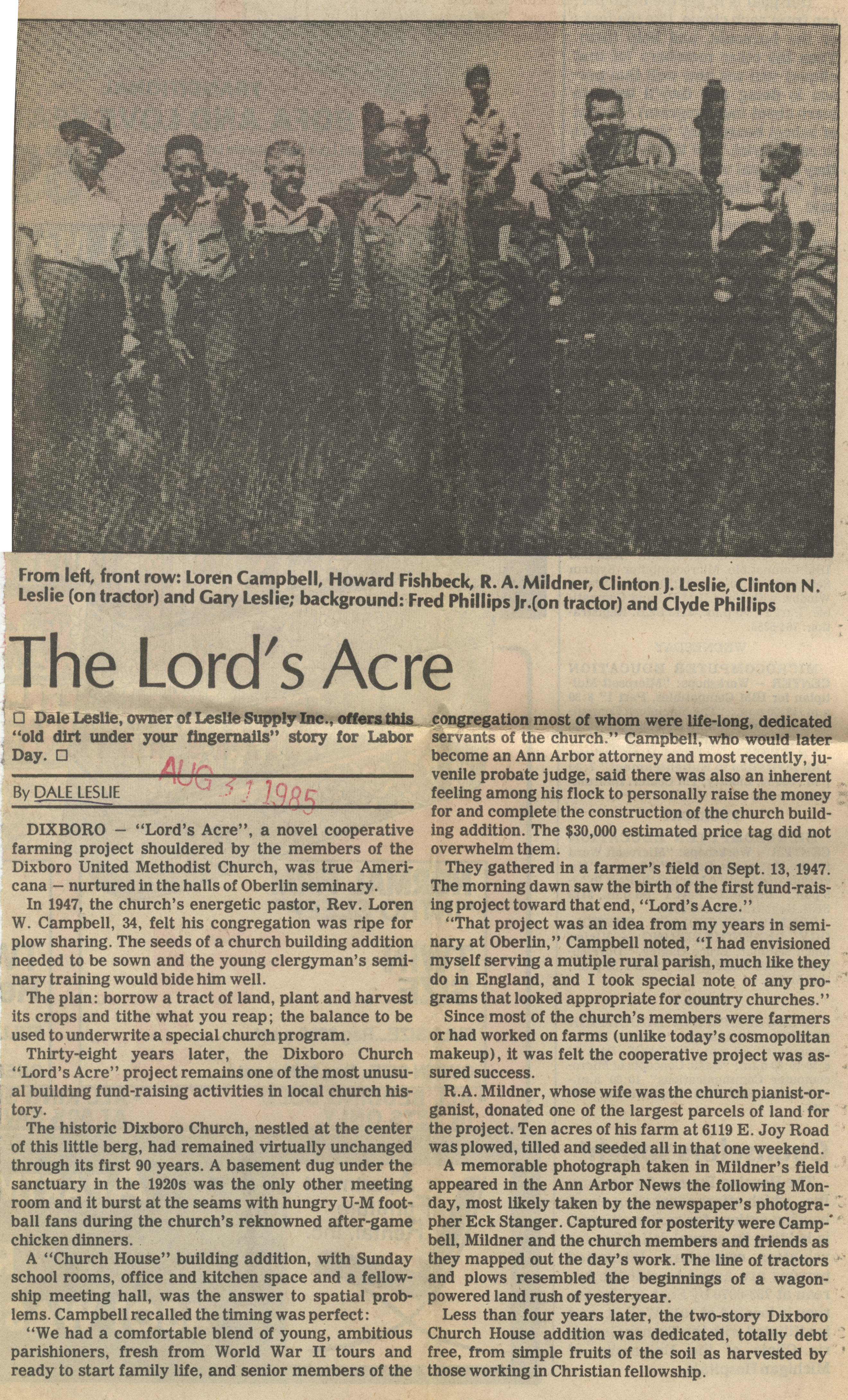The Lord's Acre

From left, front row: Loren Campbell, Howard Fishbeck, R. A. Mildner, Clinton J. Leslie, Clinton N. Leslie (on tractor) and Gary Leslie; background: Fred Phillips Jr.(on tractor) and Clyde Phillips
The Lord's Acre
□ Dale Leslie, owner of Leslie Supply Inc., offers this “old dirt under your fingernails” story for Labor
By DALE LESLIE
DIXBORO - “Lord’s Acre”, a novel cooperative farming project shouldered by the members of the Dixboro United Methodist Church, was true Americana - nurtured in the halls of Oberlin seminary.
In 1947, the church’s energetic pastor, Rev. Loren W. Campbell, 34, felt his congregation was ripe for plow sharing. The seeds of a church building addition needed to be sown and the young clergyman’s seminary training would bide him well.
The plan: borrow a tract of land, plant and harvest its crops and tithe what you reap; the balance to be used to underwrite a special church program.
Thirty-eight years later, the Dixboro Church “Lord’s Acre” project remains one of the most unusual building fund-raising activities in local church history.
The historic Dixboro Church, nestled at the center of this little berg, had remained virtually unchanged through its first 90 years. A basement dug under the sanctuary in the 1920s was the only other meeting room and it burst at the seams with hungry U-M football fans during the church’s renowned after-game chicken dinners.
A “Church House” building addition, with Sunday school rooms, office and kitchen space and a fellowship meeting hall, was the answer to spatial problems. Campbell recalled the timing was perfect:
“We had a comfortable blend of young, ambitious parishioners, fresh from World War II tours and ready to start family life, and senior members of the congregation most of whom were life-long, dedicated servants of the church.” Campbell, who would later become an Ann Arbor attorney and most recently, juvenile probate judge, said there was also an inherent feeling among his flock to personally raise the money for and complete the construction of the church building addition. The $30,000 estimated price tag did not overwhelm them.
They gathered in a farmer’s field on Sept. 13, 1947. The morning dawn saw the birth of the first fund-raising project toward that end, “Lord’s Acre.”
“That project was an idea from my years in seminary at Oberlin,” Campbell noted, “I had envisioned myself serving a mutiple rural parish, much like they do in England, and I took special note of any programs that looked appropriate for country churches.”
Since most of the church’s members were farmers or had worked on farms (unlike today’s cosmopolitan makeup), it was felt the cooperative project was assured success.
R.A. Mildner, whose wife was the church pianist-organist, donated one of the largest parcels of land for the project. Ten acres of his farm at 6119 E. Joy Road was plowed, tilled and seeded all in that one weekend.
A memorable photograph taken in Mildner’s field appeared in the Ann Arbor News the following Monday, most likely taken by the newspaper’s photographer Eck Stanger. Captured for posterity were Campbell, Mildner and the church members and friends as they mapped out the day’s work. The line of tractors and plows resembled the beginnings of a wagon-powered land rush of yesteryear.
Less than four years later, the two-story Dixboro Church House addition was dedicated, totally debt free, from simple fruits of the soil as harvested by those working in Christian fellowship.
Article
Subjects
Dale Leslie
Dixboro United Methodist Church
Ann Arbor Businesses
Eastern Michigan University - Alumni
Leslie Office Supply Inc.
Office Supply Stores
University of Michigan - Alumni
Lord's Acre Cooperative
Has Photo
Old News
Ann Arbor News
Dale R. Leslie
Loren W. Campbell
R . A. Mildner
Eck N. Stanger
6119 E. Joy Rd